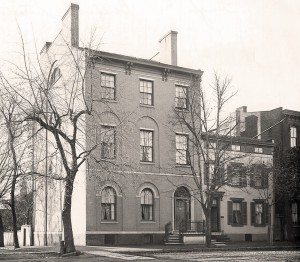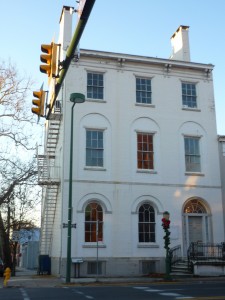The Duncan-Stiles House, 1860

Long one of the most luxurious homes in Carlisle, the Duncan-Stiles House on the corner of East High and South Bedford streets was built in 1811 for Stephen Duncan and his Philadelphia bride, Margaretta Stiles. The home was a wedding present from Stephen Duncan’s father Judge Thomas Duncan and his wife Martha Duncan. Martha designed the home in federal style with large circular rooms, Greek-detailed columns, and tall windows. Unfortunately, Stephen’s wife died shortly after their marriage and Stephen sold the home to a cousin of his wife named Benjamin Stiles and moved back to Philadelphia. Benjamin Stiles sold the home in 1840 to Reverend John Thorn and his wife Susan Hamilton Thorn. Susan was the daughter of the important local judge, James Hamilton.
By 1860 Mrs. Thorn was a widow but still living in the house. The 1860 census calculated the value of her real estate at $10,000 and her personal estate at $25,000. Also counted in the household in 1860 were two domestic servants, named Catherine Maloy and Harriet Wallace, as well as the merchant Isaac Livingston, his wife Ann, and their six children.

The size of the house, situated as it was on East High, made the structure a prime, unintended target of Confederate gunners firing into the town on July 1, 1863. The horse artillery battery was firing towards the town square from less than a mile away to the east and the home, according to Conway Hillman, son of a Dickinson College professor who witnessed the shelling as a young boy, was hit three times. One of these landed in Mr. Thorn’s bedroom, moments after she had fled from there to the basement.
Mrs. Thorn died on November 9, 1867. The local American Volunteer reported on November 14, 1867 that the “aged widow lady, residing on the South West corner of Main and Bedford Streets, was found lying dead at the door of her bedroom.”
The house has until recently served in several commercial office capacities, including a small bank, and a law office. Apartments are rented on the upper floors. An historical marker stands outside.
Leave a Reply